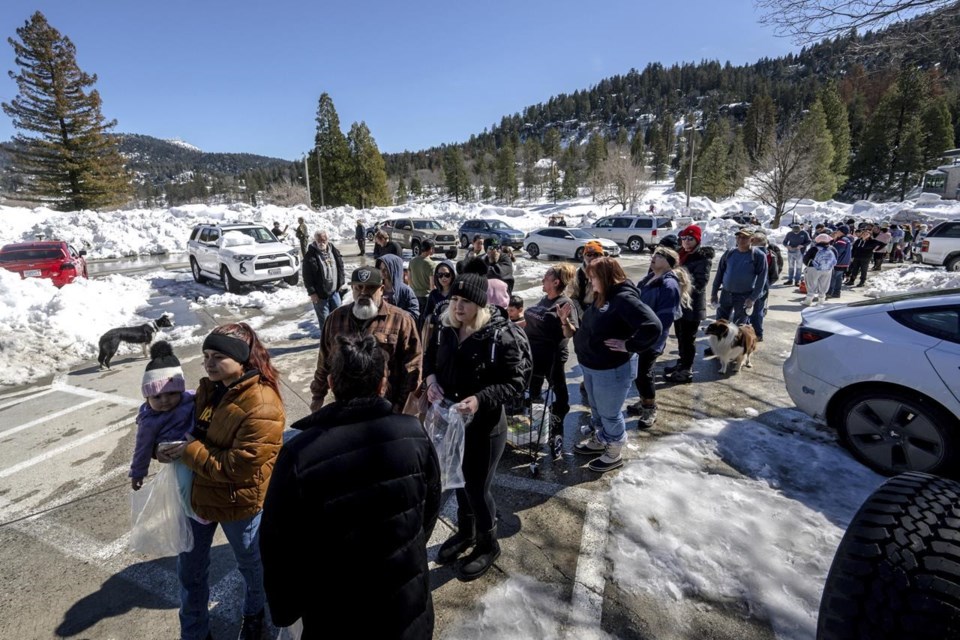LOS ANGELES (AP) — Residents of Southern California mountain towns have continued to struggle to dig out and get necessities in the aftermath of a record-setting blizzard last month that dumped so much snow that roads became impassable and roofs collapsed.
Here's a closer look at the situation:
SURVIVAL
Free food distribution centers have been set up at five locations, including the community of Crestline, which sits at an elevation of about 4,600 feet (1,400 meters).
A line of people waited there Monday to pick up food and necessities, such as toilet paper stacked in a parking lot.
“Imagine not having any food in your house after being trapped for 13 days,” resident Michelle Calkins told KTLA-TV.
Pablo Tello, another Crestline resident, picked up a replacement for a broken shovel so he could get back to helping dig snow away from homes, with special attention to buried gas lines that have been linked to several fires.
Tello said his snowshoes used to be placed over his fireplace as a decoration, but now he's using them to help his neighbors and seniors not able to leave their homes.
THE BLIZZARD
Rare blizzard warnings went into effect in late February in the mountain ranges of Southern California as an arctic air mass plunged down the West Coast, plastering California's coast ranges and the Sierra Nevada.
In an extremely unusual event, staggering amounts of snow fell east of Los Angeles in the San Bernardino Mountains and the adjacent San Gabriel Mountains, where thousands of people live or visit communities at high elevations reached by windy, steep highways.
Both mountain ranges routinely have winter snowfalls, but what looked like the foundation for epic downhill ski days instead became a nightmare.
Big Bear City received 80 inches (203 centimeters) of snow over a seven-day period, the most since these records have been tracked, according to meteorologist Alex Tardy, with the National Weather Service in San Diego. Until now, the most snow recorded in a seven-day period there was 58 inches (147 centimeters) in 1979.
Gov. Gavin Newsom declared emergencies in 13 of California's 58 counties beginning March 1.
SNOWED IN
Residents found themselves unable to leave their homes or vacation rentals, much less free their vehicles.
San Bernardino County authorities said the snowfall was so great it exceeded the capability of plows to clear roads, requiring earth-moving equipment and dump trucks to pick up and move snow.
A shortage of tire chains further hampered the response.
Highways were closed to all but emergency vehicles, frustrating residents who had been away when the storm hit and were forbidden to head back up to their homes.
Sections of key mountain roads in the Big Bear area were finally reopened Monday afternoon to residents only. The California Highway Patrol warned people returning home that they may encounter enormous snow drifts, downed power lines and potential gas leaks.
Roof collapses due to the weight of snow were reported, including a grocery store in the community of Crestline.
RECOVERY
Authorities began bringing in more snow removal equipment, organized convoys of grocery trucks, set up distribution centers and requested donations of nonperishable foods, water and general supplies.
Andrew Braggins told The Associated Press that he’s one of the lucky ones. His street in Crestline is plowed and he was able to dig out his driveway. Most of his neighbors’ properties are still buried.
Braggins and his wife have been packing their Jeep with boxes of food from the distribution center and delivering them to neighbors. But it’s not as simple as just dropping the boxes at the front doors, he said.
“We have to climb over 10-foot (3-meter) snow berms and carry them through deep snow down 60-foot (18-meter) driveways. It is exhausting,” Braggins said.
A National Guard unit that normally fight wildfires was called in to use its shovels to help clear snow.
Clearing of state routes has been done by California Department of Transportation equipment.
Highways have intermittently been open to residents as conditions permit, but authorities warn than anyone who goes down may not be allowed back up.
As of Sunday, San Bernardino County estimated that it had made nearly 80% of county-maintained roads in the area passable, meaning that at least one lane was open. But the county noted that state and county plows are not allowed onto private property and residents will have to call in contractors to do those jobs.
FORECAST
Southern California has largely seen a respite since the blizzard, but heavy snow has continue to pile up in the north, including the Sierra, where totals so far this season are being measured in the dozens of feet.
The stormy weather calmed down Monday, but accumulations were forecast to continue through midweek.
The National Weather Service said the next Pacific storm is expected to arrive in California late in the week, and will be associated with a moderately strong atmospheric river, a long plume of moisture stretching back over the ocean.
Heavy rainfall and a mild airmass could cause rapid snowmelt in some areas that have received several feet of snow recently, the service said.
The Associated Press



